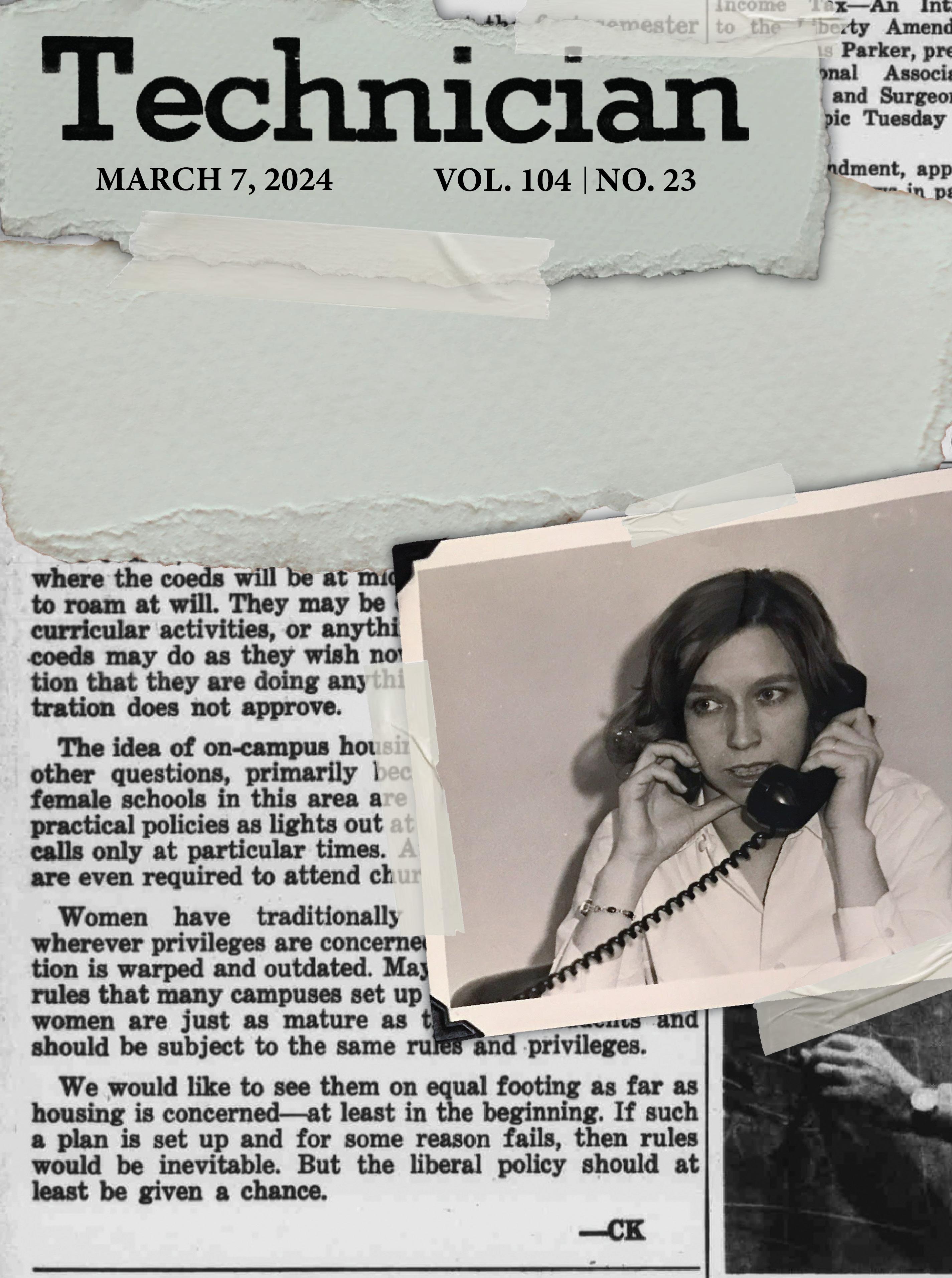
WOMEN’S HISTORY MONTH
CORA KEMP, SEE PAGE 8


Events to keep an eye on for the week of Mar. 7
CREATIVE MOVEMENT/PARTNERING WITH GASPARD LOUIS
Thursday, March 7, 5:30 - 6:45 p.m.
WELLNESS AND RECREATION CENTER AND CARMICHAEL GYM, DANCE STUDIO 2307 Free
Join Gaspard Louis for a playful creative movement partnering workshop at Carmichael dance studio. No experience required.
AUTHOR TALK: THE INTERSECTION OF FASHION AND DISABILITY
Saturday, March 9, 1 - 2:30 p.m.
JAMES B. HUNT LIBRARY, TEACHING AND VISUALIZATION LAB
Free
Kate Annett-Hitchcock will discuss her new book, which explores innovations that allow people who live with disabilities to engage with the fashion world.

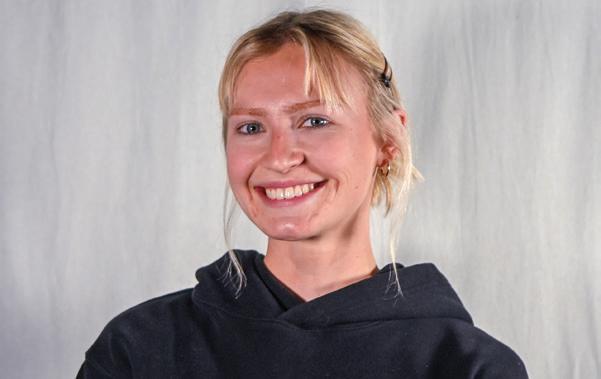

FEMINIST WRITING GROUP
Friday, March 8, 11:45 a.m. - 12:45 p.m.
TALLEY STUDENT UNION, 5210
Join the Women’s Center for a feminist writing group meeting, where students come together to write in a judgment-free space.
POPUP PI DAY TASTING
Thursday, March 14, 3 - 4:30 p.m.
PARTNERS BUILDING I (NC STATE UNIVERSITY), RALEIGH FOUNDED, SUITE 1650
Free
Attend the PopUp Pi Day Tasting for a delicious celebration of the mathematical value.
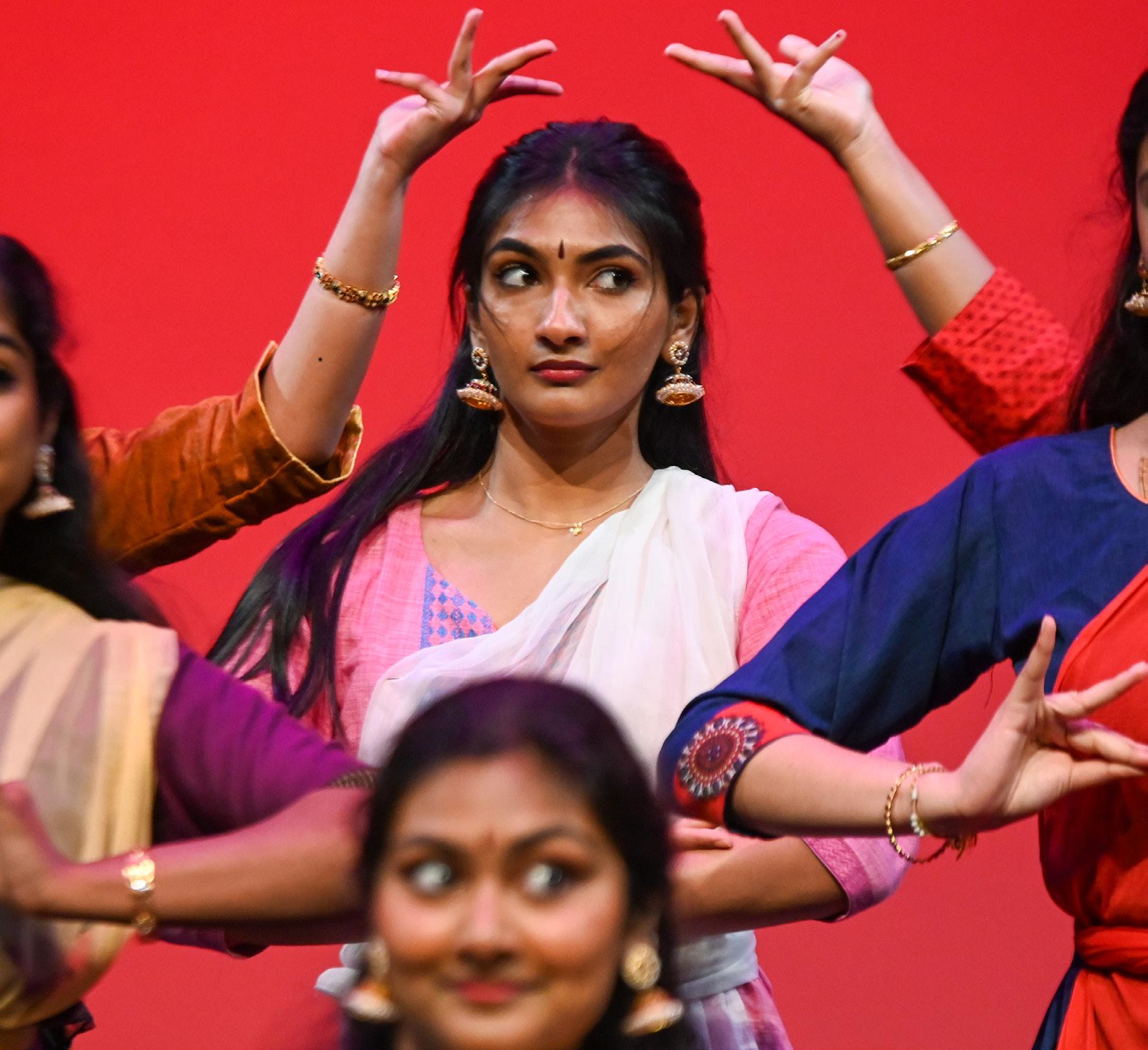
VIOLET
Thandav Dance, an NC State Indian classical dance team, performs at Asia Night in Stewart Theater on Tuesday, March 5, 2024. This event was held by the Asian Students Association and featured 12 different performers showcasing their talents.
TECHNICIANONLINE.COM 2 TECHNICIAN THURSDAY, MARCH 7, 2024 Contents IN THIS ISSUE: PHOTO OF THE WEEK page 13 SPORTS NC State women’s athletics have always been the best on campus page 08 CULTURE The women who broke up Technician’s boys club page 05 NEWS The first female student athletes of NC State page 12 The commodification of girlhood OPINION THE RADAR
Free
Technician (USPS 455-050) is the largest student newspaper of NC State University and is published every Thursday throughout the academic year from August through May except during holidays and examination periods. Opinions expressed in the columns, cartoons, photo illustrations and letters that appear on the Technician’s pages are the views of the individual writers and cartoonists. As a public forum for student expression, the students determine the content of the publication without prior review. To receive permission for reproduction, please write the editor. Subscription cost is $100 per year. A single copy is free to all students, faculty, staff and visitors to campus. Additional copies are $0.25 each. Printed by Triangle Web Printing, Durham, NC, Copyright 2022 by North Carolina State Student Media. All rights reserved. 323 Witherspoon Student Center, NCSU Campus Box 7318, Raleigh, NC 27695 Editorial 919-515-5017 Advertising 919-515-2411 Fax 919-515-5133 Online technicianonline.com COVER BY ELLIE BRUNO
BEESLEY/TECHNICIAN
Editors-in-Chief Ethan Bakogiannis Jameson Wolf technician-editor@ncsu.edu Managing Editor/Brand Manager Emily Vespa technician-managingeditor@ncsu.edu Copy Desk Chief Rachelle Hernandez technician-copydesk@ncsu.edu Assistant Copy Desk Chief Elliot Johnson News Editor Kate Denning technician-news@ncsu.edu Assistant News Editors Ally Tennant Matthew Burkhart Culture Editor Elizabeth Dull technician-features@ncsu.edu Assistant Culture Editors Riya Kannan Amelia Russell Design Editor Ellie Bruno technician-design@ncsu.edu Assistant Design Editor Carter McDermott Opinion Editor Justin Welch technician-opinion@ncsu.edu Assistant Opinion Editor Skye Crawford Focused Editor Koen Rodabaugh technician-opinion@ncsu.edu Sports Editor Colby Trotter technician-sports@ncsu.edu Assistant Sports Editors Erin Ferrare Noah Teague Photo Editors Ethan Rimolt Cate Humphreys technician-photo@ncsu.edu Video Editor Isaac Hernandez technician-video@ncsu.edu Assistant Video Editor Katherine Wan General Manager Garrett Gough media-sales@ncsu.edu
Women’s HERstory Month kickoff
Woodman Staff Writer
Buttons and stickers reading “Keep your laws off our bodies” and “Empowered women empower women” covered tables in the lobby of Talley Student Union on March 1 for the Women’s HERstory Month Kickoff.
The event provided students with activities such as friendship bracelet making and origami that promoted connection, creativity and mindfulness. The Women’s Center also gave students snacks and goodie bags containing a lavender sachet, moisturizer, lip balm and a heart-shaped worry stone.
Lauren Ramos, a third-year studying fashion and textile management, attended the event. She said the crafting tables helped connect students by providing a conversation starter as well as a reminiscent feeling of girlhood.
Ramos also said this Women’s History Month is important for bringing awareness to the current state of the nation regarding women’s rights.
“We think we’re so advanced in our nation, and I feel like we’re really not,” Ramos said. “Well, we’re going backwards at the moment, so this is a really important month.”
The kickoff also highlighted events the Women’s Center is holding during March to honor women’s achievements and promote healing and connection among students.
Rosalinda Kowalczewski, assistant director for the Women’s Center said this Women’s HERstory Month’s theme centers around the hummingbird and the butterfly, creatures who symbolize grace, resilience and transformation.
“It’s something small, but also very powerful,” Kowalczewski said. “And there’s so many different variations of a hummingbird, but at the same time, they’re all the same bird. It ties into the community and intersectionality and identity within women.”
During the event, the Women’s Center announced four specialized events to help signify the start of Women’s History Month:
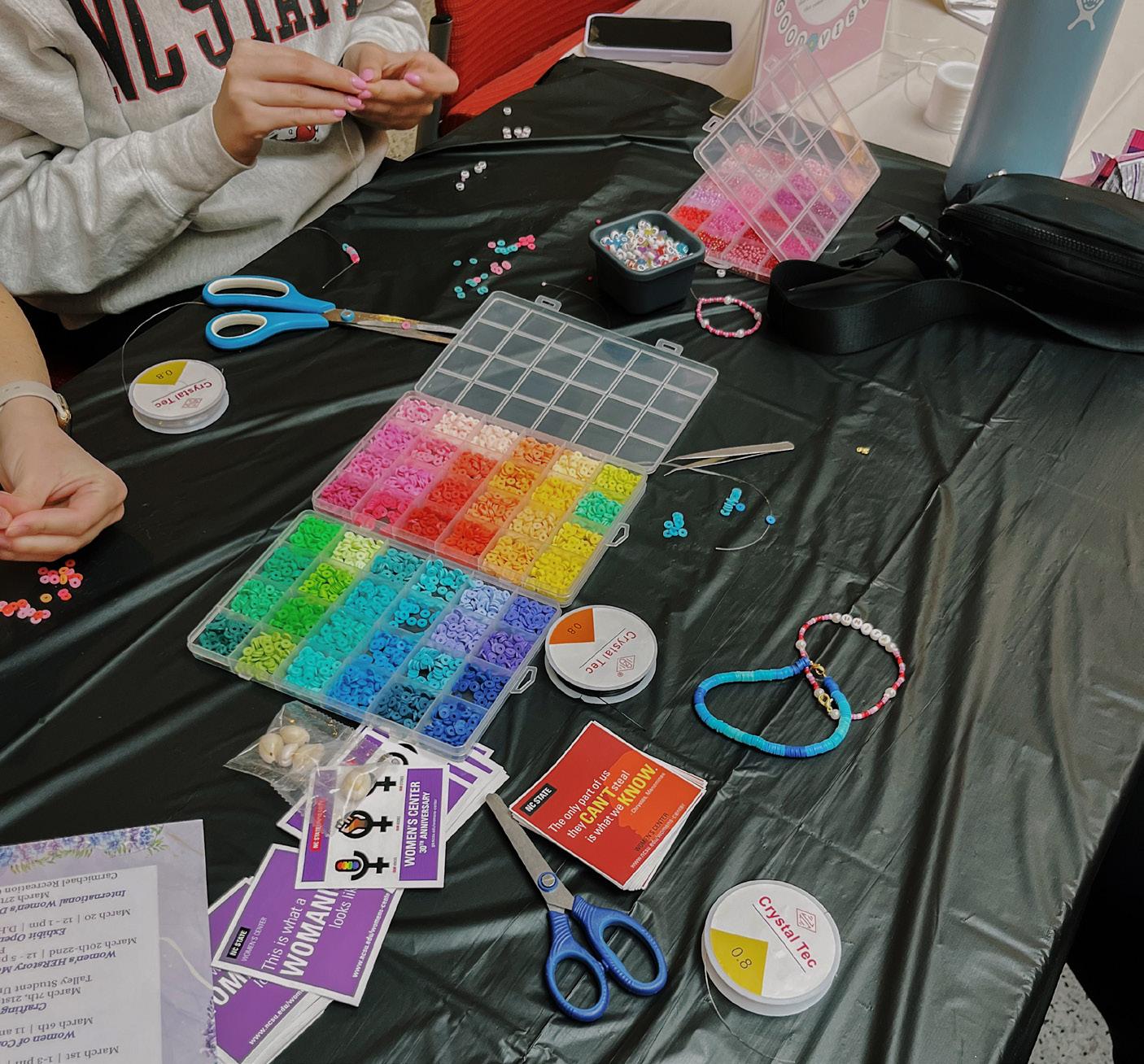
Women of Color Brunch
Multicultural Student Affairs, in collaboration with the Women’s Center, will hold a brunch in Talley Student Union Room 3222 on March 6, from 11 a.m. to 1:30 p.m. While it is a woman-of-color-centered space, the brunch is open to all students as long as they RSVP.
“It’ll be a space where they can do some crafts, affirmations, things like that, and celebrate being a woman of color or with the women of color community,” Kowalczewski said.
360 Visualization Gallery
Located on the third floor of D.H. Hill Jr. Library from March 20-22, the gallery will focus on influential women in NC State’s history. The gallery will continue
CRIME ON CAMPUS
NC State’s weekly log of major incidents across campus
INDECENT EXPOSURE BOMB THREAT
Feb. 27, 2024, at 12:41 p.m.
D.H. Hill Jr. Library
A student stated that while studying, an individual exposed himself to her. Officers canvassed all floors of the building but were unable to locate the suspect.
March 1, 2024, at 11:13 a.m.
Dorothy & Roy Park Alumni Center
An employee reported she received a phone call from an unknown subject advising a building would explode. Officers evacuated the building and requested a K-9 sweep. K-9 did not locate anything suspicious. Personnel were then given the OK to reenter the building. Report to be completed. Investigation Pending.
the symbolism of “taking flight” seen in this month’s inspiration of butterflies and hummingbirds.
The exposition will feature stories of women like Christina Koch, who set the record for the longest female single space flight and participated in the first all-female spacewalk, and the women behind an NC State air flight team called “Angel Wings.”
There will also be an interactive social media aspect of the exhibit where students can take photos in front of an installation of butterfly wings. If students post the image and tag the Women’s Center on Instagram, they will receive a free T-shirt.
Crafting + Connecting
On Thursdays throughout March there will be crafting and connecting events where students can make beaded bracelets
and necklaces as well as earrings featuring influential women in history.
Penelope Chirolde, a graduate student studying clinical mental health counseling and graduate assistant at the Women’s Center, said counselors will be present and available to help students in any way they need.
International Women’s Day at the Teaching Kitchen
In the Carmichael Recreation Center Teaching Kitchen, on March 27, from 2-5 p.m., students will have the opportunity to create pastry dishes inspired by flavors from around the world.
The menu will feature empanadas, croissants and pastries with flavors including, but not limited to, guava and cream cheese, mushroom and leek and vegetarian picadillo. The goal behind the event is to use cooking to share stories, culture and history while reclaiming a space for women.
“We want to reclaim that space as it’s been an international space across cultures, women and people have come together as a community to grow, share stories, share language, share history,” Kowalczewski said.
The event is limited to 15 students, who will be randomly selected after filling out an interest form.
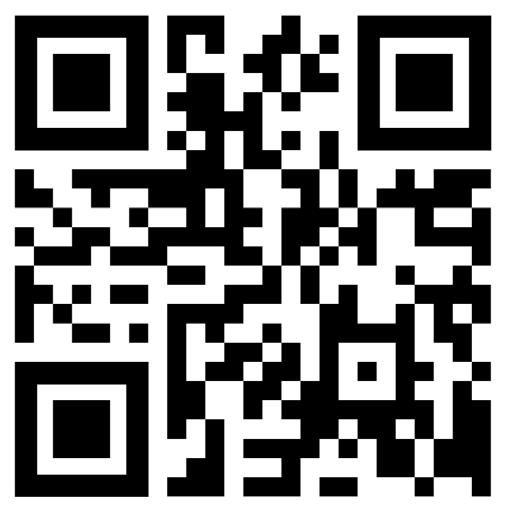
All incidents in the crime log are according to the University’s daily crime log published online in compliance with the Clery Act.
HARASSMENT
March 1, 2024, at 11:35 a.m.
Wolf Plaza
University Police responded to the Wolf Plaza area for a report of aggressive solicitors. Officer met with three unidentified individuals who were the same as previous encounters. When asked if they had received a permit from the University, they stated they hadn’t. Individuals refused to provide ID. Officer notified them that they were now trespassed and to depart University property immediately. Report pending.
SPECIAL EVENT
March 4, 2024, at 1:28 p.m.
Memorial Bell Tower
University Police responded to the area of Hillsborough Street after a protest group began marching in the middle of the road, impeding traffic. The protest organizer was issued a citation for impeding the flow of traffic.
TECHNICIANONLINE.COM TECHNICIAN 3 THURSDAY, MARCH 7, 2024 News
SAVANNAH WOODMAN/TECHNICIAN
Savannah
Scan this QR code to fill out the interest form.
The state of abortion access in North Carolina
Pierce Bruns Correspondent
After the Supreme Court effectively overturned Roe v. Wade in 2022, decisions on abortion access were turned over to individual states. While abortion remains legal in North Carolina, some say the overturning of Roe has impacted access to reproductive care.
Amanda Edwards, a professor of political science specializing in gender and sexuality studies, said legal hurdles to abortion rights have increased since the overturning of Roe v. Wade, which she thinks does not pose a great picture for the future of access in North Carolina.
“The fact that it went from 24 weeks, then Dobbs to 20 weeks, then within a year to 12 is not a great sign,” Edwards said.
Under a 2023 abortion law, North Carolina requires that a person undergoing abortion care is informed by a physician in person about the procedure they are undergoing at least 72 hours before the procedure itself.
Alison Kiser, the senior director of external affairs for Planned Parenthood Votes! South Atlantic, said she thinks these kinds of legal hindrances to abortion access are not talked about as much as they should be at the state level.
“We find sometimes that folks are more in tune with what may be going on at the federal level, but we’ve seen the harsh reality over the better part of the last 10 years of how much government interference there is at the state level,” Kiser said. “You know how much that affects the ability of young people, men, women, teens, really everyone accessing the services they need to lead healthy lives.”
Edwards said data has also shown the impact the new law has had on the number of abortions within the state, which decreased

after the 2023 legislation.
“Some of the data showed that in the first month after they changed the law, in North Carolina, they saw a significant drop in the number of abortions, right in the very first month,” Edwards said.
Kiser said accessibility across the state is also limited, with 90% of North Carolina counties being without an abortion provider, meaning many have to travel within or outside of the state.
However, Kiser said Planned Parenthood provides assistance to those in situations in which care isn’t readily available.
“We have patient navigation services available, which both helps people cover the cost of their services, as well as costs associated with travel to obtain services,” Kiser said. “So everything from gas money to lodging and childcare expenses are things
that we can help with in order to help people get to their services.”
Kiser said awareness on college campuses is something Planned Parenthood has been focusing on in North Carolina, as well as obtaining references for abortion care from campus health services.
“I would like to work with student health services wherever we’re able to for them to be able to refer patients to us for care they may need,” Kiser said. “We know that student health services are often in a position to be able to provide some services, like birth control, for example, but other healthcare services … that’s care that Planned Parenthood provides that student health services may very well not provide.”
In terms of expanding access, Kiser said Planned Parenthood is not currently looking to add more clinics to the nine it oper-
ates in the state, but that it has been working to increase availability to care through the expansion of operating hours and staffing.
“Since the Dobbs decision in 2022, we have worked in the facilities that we have to expand access to care as much as possible, doing things like being open for longer hours, expanding our facilities, adding more staff — really doing everything we can in the spaces where we already are to increase patient access to care,” Kiser said.
Despite new laws being implemented with regard to abortion access and care, both Edwards and Kiser said preventative and contraceptive products will likely stay available regardless of what happens to abortion access in North Carolina.
“The Supreme Court was pretty clear in stating that it was not meant to overflow in these other areas, such as contraception,” Edwards said. “The idea of contraception and the privacy of contraception was before Roe.”
Kiser added that while contraceptives are important, she thinks they would assume an even more important role in care if abortion becomes completely outlawed in North Carolina.
“Providing access to preventative care is a cornerstone of our mission and the services we provide,” Kiser said. “I don’t see that changing anytime soon; certainly in an environment where abortion is even more restricted or unavailable, those services would become a larger portion of the services we provide.”
Despite barriers to access that have been implemented by the state government, Kiser said the power rests with the public to maintain abortion rights.
“These are the policies that our elected leaders are pursuing,” Kiser said. “But the power of the people can stop them from being able to do that.”
Women’s Center through the years
Ally Tennant Assistant News Editor
The Women’s Center is a campus community center that has helped students for over 30 years. Professionals spoke on the Women’s Center history and resources that have helped shape NC State.
Janine Kossen, director of the Women’s Center, said the Center was founded in 1991 as a result of student advocacy.
“There was a small, but mighty, group of students who were really pushing for the establishment of a women’s center,” Kossen said. “And they worked in concert with some amazing faculty and staff who, at the time, were very invested, particularly in providing survivor support services, and
wanting to create a home for that work.”
During the ‘90s, the Women’s Center mainly provided women’s health services. However, Kossen said the Center has changed throughout the years as they began to understand there were more issues to address.
“Really understanding that this was more than just a health issue, but it was connected to larger social justice issues and gender equity issues in the end,” Kossen said.
Kossen said the Center had a rough start in its initial location in a shared space in a basement before moving to Talley Student Union.
“We had to share space; there wasn’t any institutional support and then in the
sense of physical, administrative things, like office supplies, printers, things like that,” Kossen said. “At the time, it was really a scrappy mission of trying to get the resources, then a lot of committed volunteers donated items and space to make it a space, even couches and furniture.”
Penelope Chirolde, a graduate student studying counseling education and graduate assistant at the Women’s Center, said a big part of the resources the Center currently provides is survivor services.
“This could be you know, survivors of sexual assault, domestic or dating violence, stalking, etc, who’ve had an experience, and they kind of need support on how to navigate next steps,” Chirolde said.
Chirolde said in addition to survivor
services, the Women’s Center provides volunteer work and community-building events like a feminist book club and Feminist Fridays.
“We try to provide whatever our students are asking for, so we take a lot of consideration like the climate that’s on campus and try to stay up to date with traumainformed practices and other practices that would be essential and maintain an atmosphere where people feel safe and comfortable coming to the Women’s Center,” Chirolde said.
Kossen said the Women’s Center has changed a lot over the past decade in order to fit the perspective of NC State’s campus.
“Sadly, 30-plus years later, some of those issues still exist,” Kossen said. “So think-
TECHNICIANONLINE.COM 4 TECHNICIAN THURSDAY, MARCH 7, 2024 News
CATE HUMPHREYS/TECHNICIAN Planned Parenthood Raleigh Health Center sits on S. Boylan Avenue in Raleigh on Monday, March 4, 2024. Planned Parenthood is a nonprofit that offers reproductive health care and sex education.
The first female student athletes of NC State
Bastian Hauser Staff Writer
Sixty years ago, there were no women on NC State’s athletic teams. Although the first women joined the marching band in 1946 and the cheerleading team in 1955, the first competitive sports in which women participated were fencing and rifle shooting.
In 1965, Diane Ramsey joined the varsity fencing program, and Alma Wilmington and Pam Lias joined NC State’s rifle team as NC State’s first female student athletes.
Kat Charron, an associate professor of history, researches the U.S. in the 20th century and women’s and gender history. Charron said the timing of these women joining the teams was unusual because college activism and federal law were not largely focused on women’s rights yet.
Charron said the women’s liberalization movement emerged at the end of the sixties out of the Civil Rights Movement, with some women forming separate feminist organizations.
“The timing of women students at NC State doesn’t quite fit with where we would think that would begin to happen, which would most assuredly be after 1972 and the passage of Title IX, which prohibited sex discrimination in sports, and other things,” Charron said.
Diane Ramsey, now 79, recalled why she joined the fencing team in 1965.
“When I was in college, some of the courses that you had to take were mandatory and physical education was one,” Ramsey said. “And fencing was available, and I thought that could be interesting. And so I chose it as an elective for one of the courses that I needed.”
NC State’s physical education department began offering women-only physical education classes three years before Ramsey joined the team.
Ramsey said the coach of her fencing class was Ron Weaver, who was also the coach of NC State’s fencing club. Weaver was a former member of the U.S. Olympic team, in which he competed with the sabre in 1956
ing about things like pay equity and safety, misogyny and things like that. I think, over the past decade, the Women’s Center has really leaned into focusing on intersectionality, and the intersectional identities that people experience and hold all at the same time and how those systems of oppression and the power are implicated in the identities that people hold.”
Kossen said the Women’s Center is an important space to provide community, especially for women in STEM.
“So I think even giving folks a space to kind of examine what that looks like within the STEM fields, like how does harassment show up?” Kossen said. “How does misogyny show up? How does racism and xenophobia and all of the other -isms, how do they show up particularly when you’re thinking

and as a coach in 1960.
Once Weaver invited her to join the team, Ramsey said she practiced with the men’s fencing team to get a wider experience in fencing and competed against women from other universities.
Using her experience from the team, Weaver placed third in the state women’s championship and second in the Amateur Fencers League of America.
Tim Peeler, a University communications strategist, said women could only compete as individuals before Title IX.
Ramsey said she didn’t think anything of training with men.
“I just looked at it as a person, and I needed to practice,” Ramsey said. “And I just accepted it. That was the way I was brought up. I’m not gonna run around and say I can’t do that because that’s a boy.”
The same year Ramsey joined the fencing club, Alma Williams and Pam Lias joined the NC State rifle team.
Newspaper articles from the 1960s said
about women who hold multiple marginalized identities — a woman of color or queer woman of color, trans woman of color — and how all of these spaces on this campus were not built or made for people other than white males.”
Chirolde said the Women’s Center is vital to represent the entire NC State community.
“This is a space where a lot of women can connect and see each other in the same field and outside of just the classroom,” Chirlode said. “I think in academic spaces there’s restrictions and confinement, but here, we’re open to discussing a lot of the intersectionalities that come with being a college student and being a woman of color, maybe a minority student.”
For more information on the Women’s Center, visit its website.
Williams had been a marksman since the age of eight and later taught the sport in summer camps.
In a 1966 article from The Raleigh Times, Williams was quoted saying, “My whole family is interested in shooting. All my brothers and sisters shot at camp like I did and daddy and my brothers hunt a lot.”
Lias had been shooting for two years before trying out for NC State’s rifle team. Lias said in a 1968 News & Observer article that her cousin got her interested in shooting and she later enrolled in her hometown High Point’s YMCA sharp-shooting classes.
A 1967 News & Observer article about the at-the-time five women on men’s athletic teams mentions that the swimmer Susie Resseguie was not allowed to compete on the men’s swimming team due to an Atlantic Coast Conference regulation in which only males could compete in ACCsponsored sports.
“Alma Williams and Pam Lias turned [NC State Rifle] into a coeducational team,” Peel-
er said. “They were able to get around the ACC only allowing male athletes because rifle was never an ACC sport.”
Unlike fencing, the women in riflery were able to take part in team competitions. Sgt. Tom Shafer, coach of the rifle team at the time, said Alma finished the season fourth on the team.
There were a few challenges for the women on the rifle team at the time, as they reported that even the smallest uniforms were still a little too big for them. Sharing the dressing room also got rather tense.
“I scream and they run,” Williams said in the 1968 newspaper article.
Williams said despite being one of the first women on the team, she felt welcome by her male teammates.
“The boys on the team treat me real nice,” Williams said in the 1966 article. “It’s different for both of us — they’re used to shooting with all boys; I’m used to shooting with all girls. But they seem to be proud of me when I do good.”
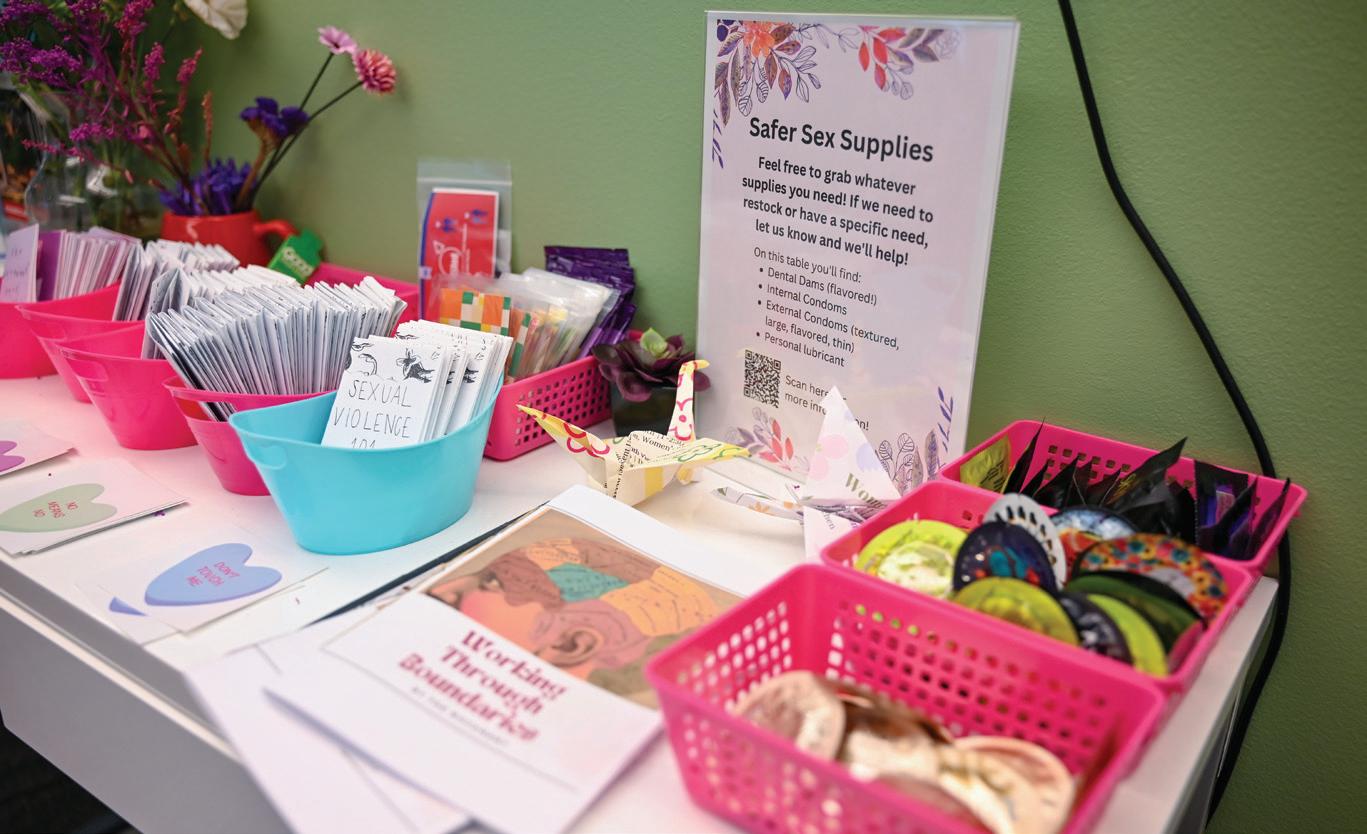
TECHNICIANONLINE.COM TECHNICIAN 5 THURSDAY, MARCH 7, 2024 News
CONTRIBUTED BY NC STATE UNIVERSITY COMMUNICATIONS AND MARKETING
CONTRIBUTED BY THE WOMEN’S CENTER
Raleigh kicks off Women’s History Month with Feminist First Friday event
Mark Mikhail Correspondent
The Feminist First Friday event, supported by First Friday Raleigh and organized by the Downtown Raleigh Alliance at The Grove in City Market, showcased over 30 local women-owned businesses, highlighting their services and products in celebration of the First Friday of Women’s History Month on March 1.
One of the event’s highlights was complimentary hair touch-ups so attendees could present themselves well in complimentary headshots. Maggie Leonhardt, the owner and co-founder of Hightide Salon, said they provided their services to show gratitude to the Downtown Raleigh Alliance.
“They’ve helped us out with many events,” Leonhardt said. “They’ve promoted for us, and they do a lot for the downtown Raleigh community. So this for us is like the least we could do to repay back everything they’ve done for us.”
The event also served as an educational opportunity for Raleigh’s youth, providing valuable learning experiences.
One of these educational stations was put on by the Marbles Kid Museum, titled “NASA’s real ‘Hidden Figures.’”
Britt Thomas, chief activation officer of Marbles Kids Museum, said their station focuses on educating the youth about the lesser-known female scientists and female innovators of the NASA program.
“We’re actually focusing on female astronauts and female scientists of NASA this First Friday,” Thomas said. “We are talking about Dorothy Vaughan and Mary Jackson, Katherine Johnson. These were scientists or female innovators early in their day.”
Thomas said the museum’s initiative is to provide learning through fun.
“Our mission is to inspire imagination, discovery and learning through play,” Thomas said. “We’re training people to be astronauts like Mae Jemison.”
Additional educational booths focused on teaching about feminine hygiene and health. Jade Watta, coordinator of mobile mammography at UNC Rex, said that her booth concentrated on spreading awareness of preventative measures for breast cancer through mammograms.
“We have a mobile mammography unit go out and see women around North Carolina,” Watta said. “We provide them with free mammograms if they’re uninsured and underserved. … I’m here tonight just to bring awareness to breast cancer — to remind women that screening mammograms save lives.”
Also a part of the educational services was The No Woman, No Girl Initiative. The nonprofit organization aims “to ensure that no woman and no girl in Wake County, NC goes without everyday essentials and hope to survive a crisis or transition.” As part of their efforts, the organization accepted donations of menstrual hygiene products to assist those in need.
Dyamond Trimble, outreach coordinator for initiative, said their organization hopes to normalize conversations about menstration.
“We do not want people to talk about period products or periods in general as if it is a weird thing,” Trimble said. “It is what our body does. It’s like using the bathroom. It is

like brushing our teeth every day. That is something that we have to take care of ourselves. To close that gap between the awkwardness, it definitely advances that cause for feminism. So we can know and be educated … for all people
to be educated about the cycle of our bodies, as a woman.”
The No Woman, No Girl Initiative will hold a Women’s Day event March 16 at Longleaf Swine BBQ. Attendees will receive complimentary barbecue.
TECHNICIANONLINE.COM 6 TECHNICIAN THURSDAY, MARCH 7, 2024
Culture
GRAPHIC BY AMELIA RUSSELL
NC STATE’S FEMALE ALUMNI CROSSWORD
DOWN
1) The first female student to officially enroll in classes at NC State.
2) This student was the first woman to earn a mechanical engineering degree from NC State and the first female engineer at the Federal Aviation Administration.
3) This graduate is one of the first few Native American women to hold a doctorate in mathematics.
6) The first woman to graduate from North Carolina State College and a prominent North Carolina agricultural educator.
7) The “First Lady of Statistics,” this statistician founded the NC State statistics department.
10) This women’s basketball coach is the fifth-highest winning NCAA Division I coach, racking up over 700 wins during her tenure.
ACROSS
4) This woman was the first female student to earn a master’s degree from NC State and first female Alumni Association officer.
5) This alum will be the first woman to go to the moon.
8) The first female chancellor of NC State and recipient of the 2010 National Medal of Science.
9) This student was the first female editor of Technician.
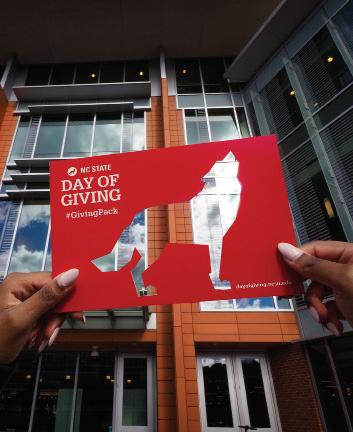

TECHNICIANONLINE.COM TECHNICIAN 7 THURSDAY, MARCH 7, 2024 Culture NC State’s sixth annual Day of Giving is coming up on March 20. From scholarships to programs to campus enhancements, Day of Giving donors help make your NC State experience extraordinary. And this year we have a special challenge just for you: By completing two actions at the link below, you’ll be able to designate a portion of bonus funds to go to your favorite area at NC State AND claim your exclusive NC State swag and food at one of our Day of Giving hubs. Learn more at dayofgiving.ncsu.edu/info/students DAY OF GIVIN G 03.20.2 4 Build your own custom worksheet at education.com/worksheet-generator © 2007 - 2024 Education.com women's history
crossword 1 2 3 4 5 6 7 8 9 10 Across: female student 4. master's degree engineering 5. female astronaut first native woman to earn a phd 8. chancellor female grad 9. technician statistics basketball coach ®
month

The women who broke up Technician’s boys club
Emilia Rivadeneira Staff Writer
Upon its founding in 1920, Technician’s editorial board consisted solely of men. This pattern continued for over four decades — until Cora Kemp came along.
In 1964, Kemp became the first female editor-in-chief of Technician’s Vol. 49.
Her journey on the editorial staff, however, goes back to 1961, when she became assistant news editor as a first-year student. In 1962, two years before taking the position of editor-in-chief, she also served as features editor.
“The one thing I did know about Cora and learned about it from her husband was that she didn’t have big, big dreams when she came to NC State,” said Tim Peeler, a public communications specialist at University Communications. “Coming to NC State, specifically working at Technician, really opened up her opportunities, and that’s what NC State has done to many people through the years.”
Peeler said Kemp was someone who took advantage of opportunities and reached for bigger dreams.
“Cora was not just the Technician editor; she was an activist on campus,” Peeler said. “She helped get things changed, specifically with the integration of the restaurants on Hillsborough Street, and she maintained that same kind of tenacity — that’s a really
good word for her. They called her ‘Cora the Cobra.’ She made a difference.”
And Kemp did make a difference on campus, using journalism as her main outlet of activism.
The same year she was named editor-inchief, the opening of the first coed dormitory on campus was announced. Many discussions took place regarding the issue, and Kemp was at the forefront of it.
In an editorial published on March 12, 1964, titled “Why Have A Difference,” Kemp wrote on rules and regulations the University was imposing on women.
“Actually, there would be no problem if the administration would allow the coeds to live under the same rules and regulations that the male students do,” Kemp wrote. “Women have traditionally led a sheltered life wherever privileges are concerned. But sometimes traditions are warped and outdated. ... We think women are just as mature as the male students and should be subject to the same rules and privileges. We would like to see them on equal footing as far as housing is concerned.”
Kemp advocated for liberal policy regarding housing. Her words made an impact and helped move campus toward gender equality during her time at Technician.
Forty volumes and almost four decades later, Carie Page, former Technician editorin-chief of Vol. 85, walked inside of Technician’s newsroom the day after 9/11. She was
a freshman with the intention of becoming part of the staff and doing something bigger than herself.
Page said she remembers entering the newsroom and seeing a lot of people working, but not all of them were men — in fact, it was a female news editor that took Page under her wing.
Cora was not just the Technician editor; she was an activist on campus. ... They called her ‘Cora the Cobra.’
- Tim Peeler
sense of belonging. … I was really lucky that I had that. … If I had walked into Technician that first day and only seen men in the newsroom, I might have had a different inclination.”
At the end of her sophomore year, she was offered the role of editor-in-chief alongside her future co-editor, Thushan Amarasiriwardena.
During her time at Technician, Page spent a lot of time revisiting its archives. When she became editor-in-chief, she went through a deep dive to know what women were in the position before her.
“I think it is always reassuring to know that someone has already broken the barrier, right?” Page said.
Page found that before her there were only three female editors including Kemp.
“I have to say, ... I’m realizing now like, I don’t know that I really at the time grasped how few females there had been until I’m looking at this list,” Page said. “I knew there had been some before, so I knew I wasn’t going to be the first. I don’t think I realized that it was a little bit, it was still a little bit of an aberration. That’s crazy. I’m glad it’s not the case anymore.”
“I walked in that first day, and I saw an amazing woman who said, ‘Hey, I’m doing this, you can do this. Let me show you how,’” Page said. “I think in order to create a system where you bring diverse voices in, they have to be there so that people feel that
Both Kemp and Page’s legacy are still felt within and outside of the walls of Technician’s newsroom. Their passion for journalism and activism on campus is remembered and carried within every woman that makes up Student Media today.
TECHNICIANONLINE.COM 8 TECHNICIAN THURSDAY, MARCH 7, 2024 Culture
GRAPHIC BY EMILIA RIVADENEIRA
‘Dune: Part Two’ is among the unforgettable movies of this generation
Kelsey Bohn Correspondent
The second film in Denis Villeneuve’s three-film remake of “Dune,” the classic 1965 sci-fi novel, was released March 1. “Dune: Part Two” reminds an instantstreaming world of the awe-inspiring experience only the movie theater can deliver. The dedication to preserving the integrity of the carefully designed politics, culture and characters of the original novel, while still translating it into a well-paced visual phenomenon, has earned “Dune: Part Two” the title of one of the greatest sci-fi films of all time.
The first movie in the trilogy, “Dune,” was highly acclaimed, securing six Academy Awards. To live up to the first movie and early reviews comparing “Dune: Part Two” to iconic films such as “The Dark Knight” and “The Empire Strikes Back,” it needed to leave audiences speechless — and it did just that.
which media is ubiquitous,” Fyfe said.
The film follows Paul Atreides, played by Timothée Chalamet, as he is thrown from a life of sheltered nobility into becoming the prophesied Messiah, who is the foreseen leader of the entire Fremen tribe of Arrakis.
“Dune: Part Two” found time to provide compelling arcs for all its characters even amidst the chaos of mass political conflict, including the looming possibility of war.
Dune’s setting consists of thousands of miles of sand, under which monstrous sandworms lurk beneath the surface. Sandworms are sensitive to vibrations, including those from footsteps, which make the sound essential to the audience’s experience.
“The soundtrack of Dune by Hans Zimmer and the particular choices made to really distinguish the sonic texture of the experience from other movies and other big soundtracks are really fascinating,” Fyfe said.

Dune dreams big. It finds a landscape with its own massive scale, the sense of the endlessness of the deserts and of the sky.
- Paul Fyfe
“Dune: Part Two” is at the top of the list for “must-see-in-theater” movies of 2024. The massive scope and immense detail of the environment seamlessly bridge the gap between the audience and a foreign universe that took Frank Herbert, the author of the original “Dune” novel, six years to research and write.
The dedication to the intricate ecosystem within Dune and the breadth of the visuals centered around the environment remind the audience of its integral impact on the story.
“It is a story about immersion in a new world, where the Atreides family is required to inhabit this entirely new place,” Fyfe said. “Dune dreams big. It finds a landscape with its own massive scale, the sense of the endlessness of the deserts and of the sky.”
The complex characters and dense narrative within the Dune franchise contribute to much of its success. However, its production, from the soundtrack to the cinematography, also deserves credit. Paul Fyfe, an associate professor of English, teaches ENG 376, a course dedicated to unpacking science fiction, said it’s refreshing to have a science fiction franchise developing its own distinct visual experience and soundtrack.
“Dune is part of a broader trend to continually reinvent the in-person, big-screen cinematic experience for an audience to
While very successful, the first Dune movie received criticism for its densely packed exposition and slow pacing. “Dune: Part Two” creates a delicate balance as it expands the complexities of its politics and characters by using the much-needed exposition from “Dune: Part One” to allow for a thoughtful, but action-packed, narrative.
“In some ways, I hope that Dune doesn’t just become blockbuster big battles all the time but continues to explore what the cinematic narrative possibilities of its own slowness are,” Fyfe said.
A third movie in the Dune franchise has not yet been formally announced, but Villeneuve has confirmed it to be part of his vision for the film series.
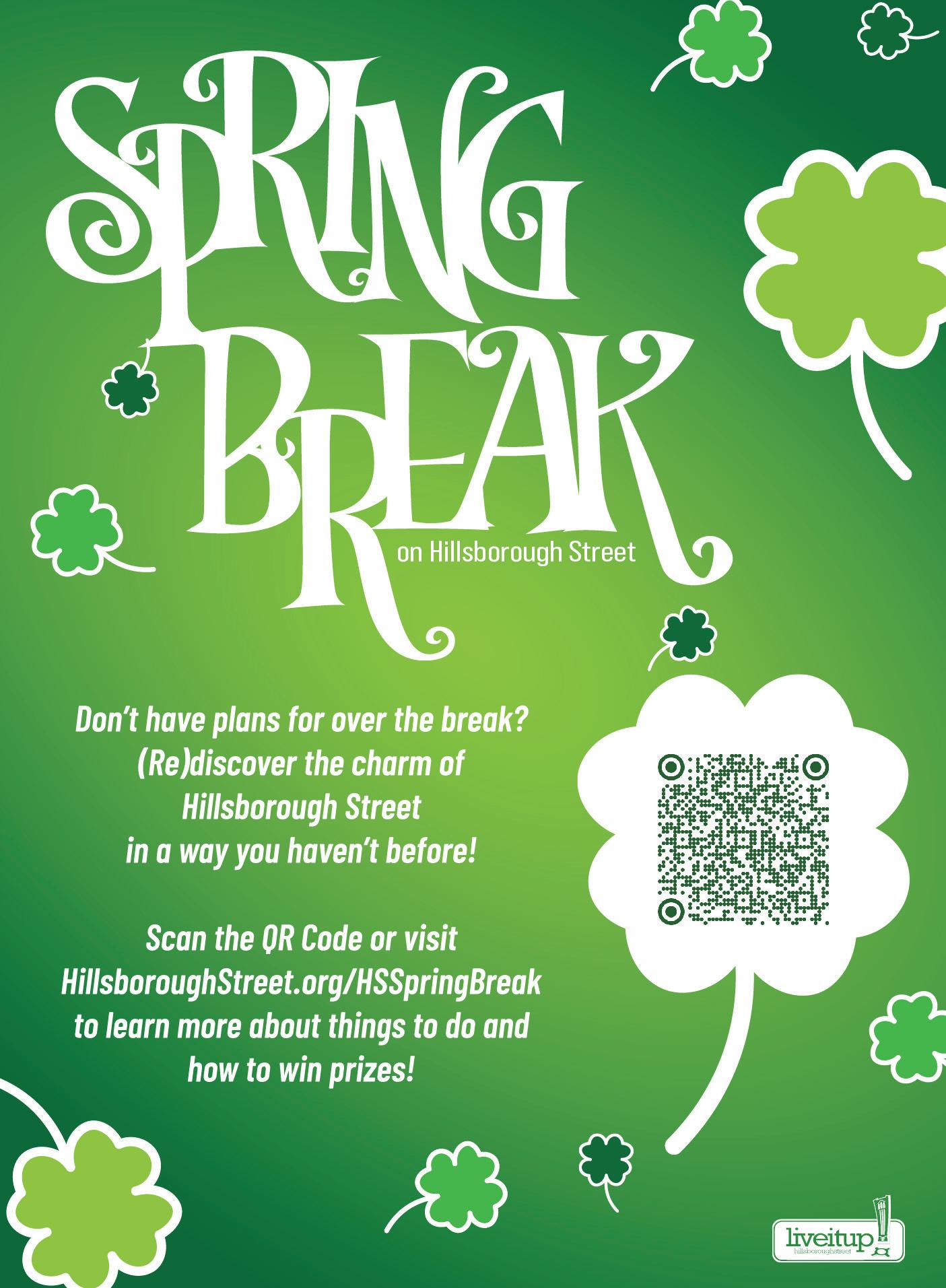
TECHNICIANONLINE.COM TECHNICIAN 9 THURSDAY, MARCH 7, 2024
Culture
GRAPHIC BY AVERY SZAKACS
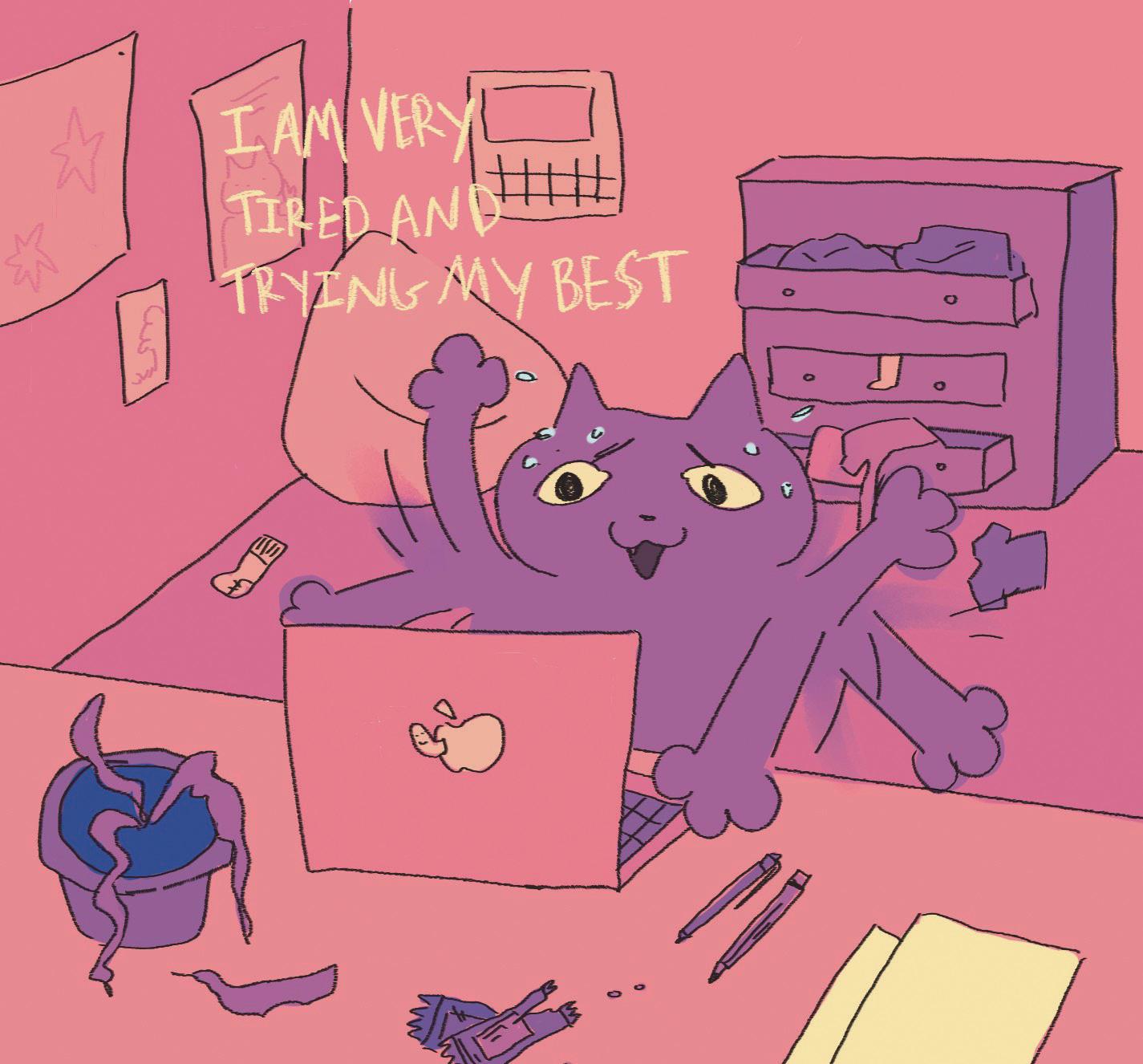


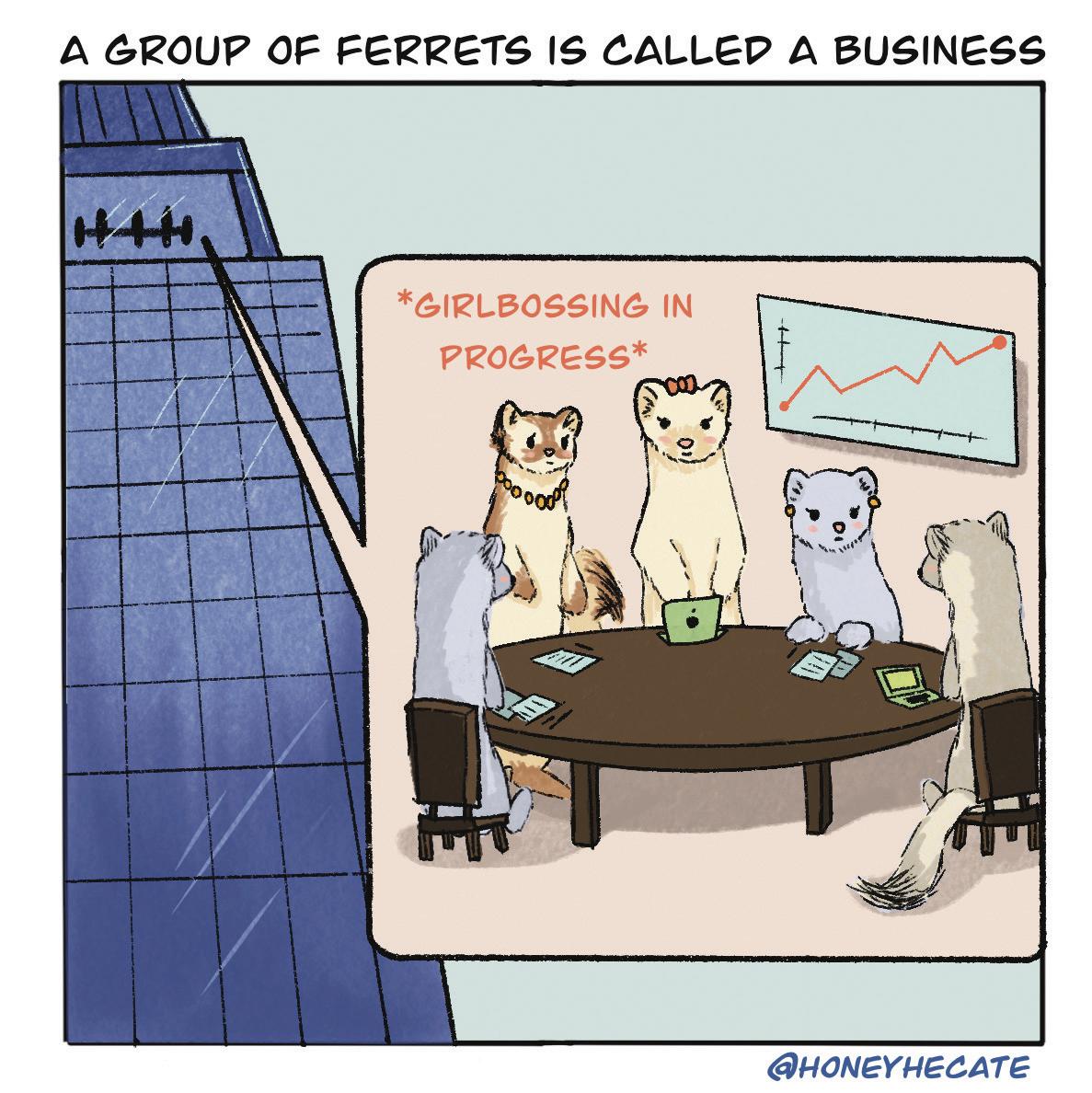
TECHNICIANONLINE.COM 10 TECHNICIAN THURSDAY, MARCH 7, 2024 Comics
Trying Avery Szakacs, Staff Cartoonist
A third-year studying art and design
Tight-knit Sophie Gabriel, Staff Cartoonist
A third-year studying art and design
Women-led Business
Jordan Ramsey, Staff Cartoonist
A third-year studying art and design
Branches
Lucy Osborn, Staff Cartoonist
A third-year studying art and design
WOMEN’S HISTORY MONTH PROFILES
Nina Simone is still misunderstood
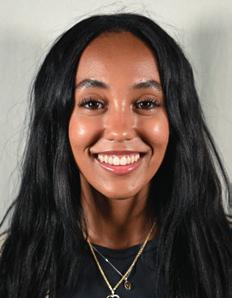
Rocky Berhe Correspondent
Editor’s Note: This article contains references to drug use and addiction.
Nina Simone spent her entire life with one goal in mind: following in the footsteps of her heroes Bach, Brahms, Chopin and Schubert. The prodigious Eunice Waymon, as was her birth name, dreamt of growing up to be the first Black female concert pianist. As we approach 21 years since the death of the North Carolina native and “High Priestess of Soul,” why do conversations about the musician still center on her mental health and sexuality?
Nina Simone was an earnest and true artist, indifferent to the prospect of securing a recording contract. Her dedication remained to her craft. Simone’s talents were inspired by the greats and inspiration for the greats. She has been praised by the likes of Miles Davis, John Lennon, Aretha Franklin, Cat Stevens and more. Why is it, then, that when Simone is brought up, it is in conversation about complex women and tortured artists?
Nina Simone was, without a doubt, a complicated woman, but she is no more complex than Miles Davis or even her civil rights contemporaries, Rev. Martin
Luther King Jr. and Stokely Carmichael.
Nina Simone was a troubled Black woman from a large, rural Carolina family. Diagnosed with bipolar disorder, drugaddled and drunk, her darkness poured into her work. She couldn’t help but express her madness through music. This is typically the narrative when discussing Simone and other talented women. By claiming they couldn’t help but create masterpieces of art, we are saying deliberation is not a trait women possess.
When discussing mental illness and art, we have a habit of characterizing men as talented despite their struggles and women as gifted because of their struggles. “The Bell Jar” is not the work of Cambridge alum Sylvia Plath; it is the work of a deeply troubled housewife who didn’t know what to do with herself.
Eunice Kathleen Waymon was born Feb. 21, 1933, in Tryon, North Carolina. Simone’s musical inclinations were nurtured as a young child by her father who was a barber, dry cleaner and entertainer, and she was encouraged to perform by her mother, a Methodist preacher. She played piano at church for her concert debut at age 12.
This recital was pivotal for the future civil rights activist. Simone’s parents, who were seated in the front row, were forced to move to the back of the church to make room for white people. Simone refused
to play until her parents could return to their seats in the front row.
Simone received monetary support from friends and family to pursue her musical talents outside Tryon. A local fund allowed her to attend Allen High School for Girls in Asheville. Following her graduation as valedictorian, she studied under Carl Friedberg at Julliard in New York. She was preparing for an audition at the Curtis Institute of Music in Philadelphia, where she was ultimately denied admittance. Her audition was very well-received, which led Simone to believe the rejection was due to racism. This initial rejection was the first of many throughout the course of Simone’s career.
Despite critical acclaim, Simone wasn’t able to experience mainstream success, and, more importantly, she never enjoyed the financial fruits of her labor.
Nina Simone was a prodigy, just like Miles Davis and Mozart. At just 6 months old, she could recognize musical notes, and by 3, she was fully capable of playing piano by ear. Her talent was undeniable long before she took her first drug or had her first affair. Simone’s skills were not fine-tuned by her emotions but rather by the most prestigious music institution in the world.
This isn’t to trivialize her struggles or suggest they had no impact on her work. They certainly influenced the subject
matter of her songs, but my point is that Simone’s emotional state is not responsible for the quality of her work.
Simone was led to the Atlantic City jazz club that started her career as a vocalist for the very practical reason that it paid double what she was earning teaching piano in Philadelphia. She adopted her stage name for an even more practical reason: She didn’t want her mother to know she was singing in a seedy bar. There was no spiritual motivation; she didn’t feel trapped within the confines of her Southern Methodist roots — she simply found a way to make more money and did what any reasonable person would do. All artists are influenced by their emotions, and all people, regardless of their field of interest, deal with complex and challenging emotions. Our habit of referring to talented individuals who belong to marginalized groups as “tortured artists” is another way to justify our subconscious belief system that art created by cis-gendered, white men is not only superior, but the default.
If it wasn’t clear already, Nina Simone had more talent in her pinky finger than many men have in their whole body, and this talent did not manifest because of her emotional instability but because of her lifelong commitment to honing her skills in the same vein as the composers who inspired her.
Audre Lorde spearheaded intersectionality
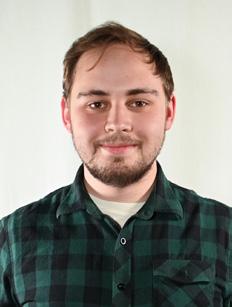 Will LaMarche Staff Writer
Will LaMarche Staff Writer
In recent years, a lot more of us have become familiar with the term intersectionality. While the term was popularized by Kimberlé Crenshaw in a 2016 TED Talk, the phenomenon had been widely observed and discussed by artists and writers for decades. One of the most prolific artists who wrote about the intersections, or in her own words, “worlds,” she existed at, was Audre Lorde. Audre Lorde was born on Feb. 18, 1934, in New York City to Grenadian-immigrant parents. She began writing poetry as a young adolescent and was published in Seventeen magazine before graduating high school. Years later, Lorde would go on to study at the National University of Mexico in Cuernavaca, complete her undergraduate degree at Hunter College and gain her graduate degree in library sciences at Columbia University. At this time in Lorde’s life, she became more con-
fident in her identity as a lesbian poet. Lorde was married to Edwin Rollins, a white, gay man, for eight years. In that time they had two children, Elizabeth and Jonathan, before they divorced in 1970. Two years later, Lorde would meet her partner, Frances Clayton, who she would stay in a loving relationship with for nearly 20 years. During this time Lorde worked as a librarian in the New York Public School system.
From 1968 to 1972, Lorde published three poetry collections, and would publish three more in the six years following. While Lorde’s poetry had always been about her intersectional identity, it was in the 1970s and 1980s that her poetry on being a Black lesbian began to capture the public.
Her poem “A Woman Speaks” illustrates the perception and history of Black women in a way that re-emphasizes that white and Black women do not have the same lived experiences.
In a 1978 poem, “A Litany for Survival,” Lorde wrote about generational trauma
and the fear that comes with living as a marginalized person in America.
Another poem, “Afterimages,” describes the trauma Lorde and the Black community experienced, particularly after the death of Emmett Till.
Lorde also published a few essays, one being “The Master’s Tools Will Never Dismantle The Master’s House.” In that essay, Lorde writes about “racist feminism” and how the notion that it is the job of Black women to educate women on racism and men on patriarchy fails to dismantle those systems. Instead, she argues that we have to look critically at our world, where we sit in it and what that means for the choices we make.
In 1977, Lorde was diagnosed with breast cancer. She kept journals and wrote extensively about the preparation for and recovery from her mastectomy. She later adapted these journals into a book, “The Cancer Journals.”
Throughout her journals, Lorde reconsiders the various “worlds” she inhabits and moves through as a Black lesbian
mother and poet as she is faced with her own mortality. She uses “The Cancer Journals” to define herself by herself.
Lorde also reflects on the care and lack thereof she has experienced during the process of cancer diagnosis, mastectomy and recovery. In some instances she speaks about how women, particularly queer women, were with her every step of the way. In others, she describes how much of the rhetoric surrounding breast cancer at the time was not focused on stopping the causes of cancer or implementing better practices for treating it.
While Lorde did survive her first diagnosis, she tragically did not survive the return of her cancer years later and died in 1992. From 1991 to 1992, Lorde acted as Poet Laureate for the state of New York.
Lorde’s life and work was never just about her identity; it was about the communities she shared and the love and compassion that could be. In her own words: “It is not our differences that divide us. It is our inability to recognize, accept and celebrate those differences.”
TECHNICIANONLINE.COM TECHNICIAN 11 THURSDAY, MARCH 7, 2024 Opinion
The commodification of girlhood

Online, the lives of people, especially women, are dictated by the aesthetic they want to portray to their audience, often communicated through products and commodities. But what happens when the tangible indicators of your persona are simply commodities? Does that make you a product of your products?
Recently, the word “girl” has been attached to as many objects and activities as influencers can find to show how life is done differently under that month’s chosen microtrend. From girl dinners and clean girl hairstyles to hot girl walks and coastal cowgirl room decorations, the list goes on a mile.
When you’re bad at math or driving you’re “just a girl.” At this point, the internet has co-opted the meaning of “girl,” deconstructing what and who you identify as through commodities sold to us
with a pink bow to seal the deal.
There is so much money to be made by selling things to women with a “girlhood” state of mind.
Musicians like Kacey Musgraves and Olivia Rodrigo brand their merchandise to mimic early 2000s magazines so that people who long to be a part of the unattainable past can catch a glimpse into what it was like. You need to look no further than Taylor Swift and the Super Bowl to see that celebrities define culture whether we like it or not, and in turn they yield a huge amount of economic power.
A lot of the people online desperately spouting the kind of girl they are and participating in these trends are women inching toward 30. Is the label of girlhood on each aspect of life a desperate cry for what life once was? Maybe the propensity to embrace girlhood is a dismissal, or even rejection, of womanhood as we know it.
We are socialized to believe that younger almost always equals better. Skincare products are advertised to “reverse” ag-
ing, and older men in movies are coupled with younger women a majority of the time.
It is not surprising that women perform these battle cries to show and claim their value as an individual, or to escape their destined womanhood. “Woman dinner” has far less of a ring to it than “girl dinner.”
If you lose power as you age, then to claim eternal girlhood is a blip in the system, right?
I cannot write this without admitting that I do the same — I make Pinterest boards of clothing and jewelry I hope to own. I listen to certain music I think I should like and post photo dumps of my life to show people what I’m doing. I’m easily convinced and change my hobbies based on who I aspire to be. However, girl-coding these activities makes it way too easy for companies to use them as marketing tactics.
Nobody is born wanting a curated collection of items that explain who you are. It has become very common for women
to rely on these commodities, whether they already own them or purely aspire to own them. It’s tough to decipher if we can even know what it is like not to exist as something to be either marketed to or sold.
I’m tired of being told I need to buy something to attain the meaning of girlhood.
I would like to exist in a world where my life isn’t a marketing campaign, and I would like to scroll on social media without an influencer telling me I need x, y or z. I don’t want my value as a female person to be reduced to the things I own, but there aren’t many other options.
Trends come and go. Soon, the internet will surpass “girl”-labeled trends and move on to something hopefully more interesting. It will likely be marketed to girls, once again, because it is easier to sell something to someone who has been raised to care about how they are perceived. Let’s just make sure we all buy the right makeup so when we cry in the mirror, we look pretty in the moment.
EDITORIAL: Students have power within the University — time to use it
There were four tickets for student body president and vice president in last year’s Student Government election. This year, students had just two options — the current student body vice president or an abstention.
The lack of competition in this year’s campaign was emblematic of apathy within Student Government and in the campus community as a whole. In this session of Student Government, only 63 of the available 72 seats were filled.
The Senate has not been full since before the COVID-19 pandemic, nearly half a decade ago.
This is an embarrassing reflection of the NC State community’s participation in University happenings, and it’s an indictment of the inconsequential nature of the state of today’s Student Government.
The student body president holds a seat on the NC State board of trustees. This is the only seat on the University’s most powerful body that is held by a student, and it should be a coveted role: The student body president is granted the privilege of representing the interests of the entire student body to the University’s most influential
individuals. Students squander this great potential to have their voices heard when they allow the position to essentially be handed to an individual uncontested. It’s detrimental to meaningful advocacy on behalf of the student body.
And Student Government doesn’t just advocate at the University level, it advocates to the UNC System. When UNC System President Peter Hans announced plans to ban Yik Yak from campus networks across the UNC System on Thursday — much to the chagrin of some students — he specifically cited student body presidents as playing a pivotal role in this move.
“I had never heard of these apps until a group of student body presidents told us about their ubiquitous presence on campus,” Hans said.
Members of our Student Government are part of the UNC System’s Association of Student Governments, and the ASG president represents students to the Board of Governors. Student input at the University level
can impact changes enacted at public universities across the state, if you even care.
The singular campaign for student body president left much to be desired. Markert and Carreno’s platform clearly existed in the context of being uncontested — it offered glib musings on campus issues but lacked effective, well-thought plans to truly tackle them. 2023’s plethora of campaigns created extensive discourse on a multitude of issues and provided students with a variety of choices.
While there wasn’t anything particularly wrong with Markert and Carreno’s platform, it was simply too broad to adequately address any of the issues that face campus today. Blanket statements and unspecific goals encouraged a low bar of achievement in line with the already meager expectations of our student representatives. This sentiment extended to student senator campaigns, which were equally ambiguous and clouded with political buzzwords.
This is not about the candidates themselves. It’s about a broader trend of a lack of engagement with the very avenue students are given to drive change.
Go to a Student Senate meeting. Meet with student body officers or senators about your concerns. It’s Technician’s role to hold Student Government accountable and keep campus informed, but to create a sincere and productive body that can aptly represent the varied interests of students, we need more participation from the NC State community.
With strong commitment from diverse student perspectives, Student Government can be a powerful catalyst for change on campus. Technician hopes to see more candidates in the future.
In the meantime, we’d be remiss not to mention another powerful platform for the student voice: Technician.
Technician endeavors to be a meeting place for campus opinions, and we always welcome guest submissions. To learn more about our submissions guidelines, visit our website.
TECHNICIANONLINE.COM 12 TECHNICIAN THURSDAY, MARCH 7, 2024 Opinion
Sarah Hoffer Staff Writer
The unsigned editorial is the opinion of the member’s of Technician’s editorial board, and is the responsibility of the editors-in-chief.
COLUMN
NC State women’s athletics have always been the best on campus
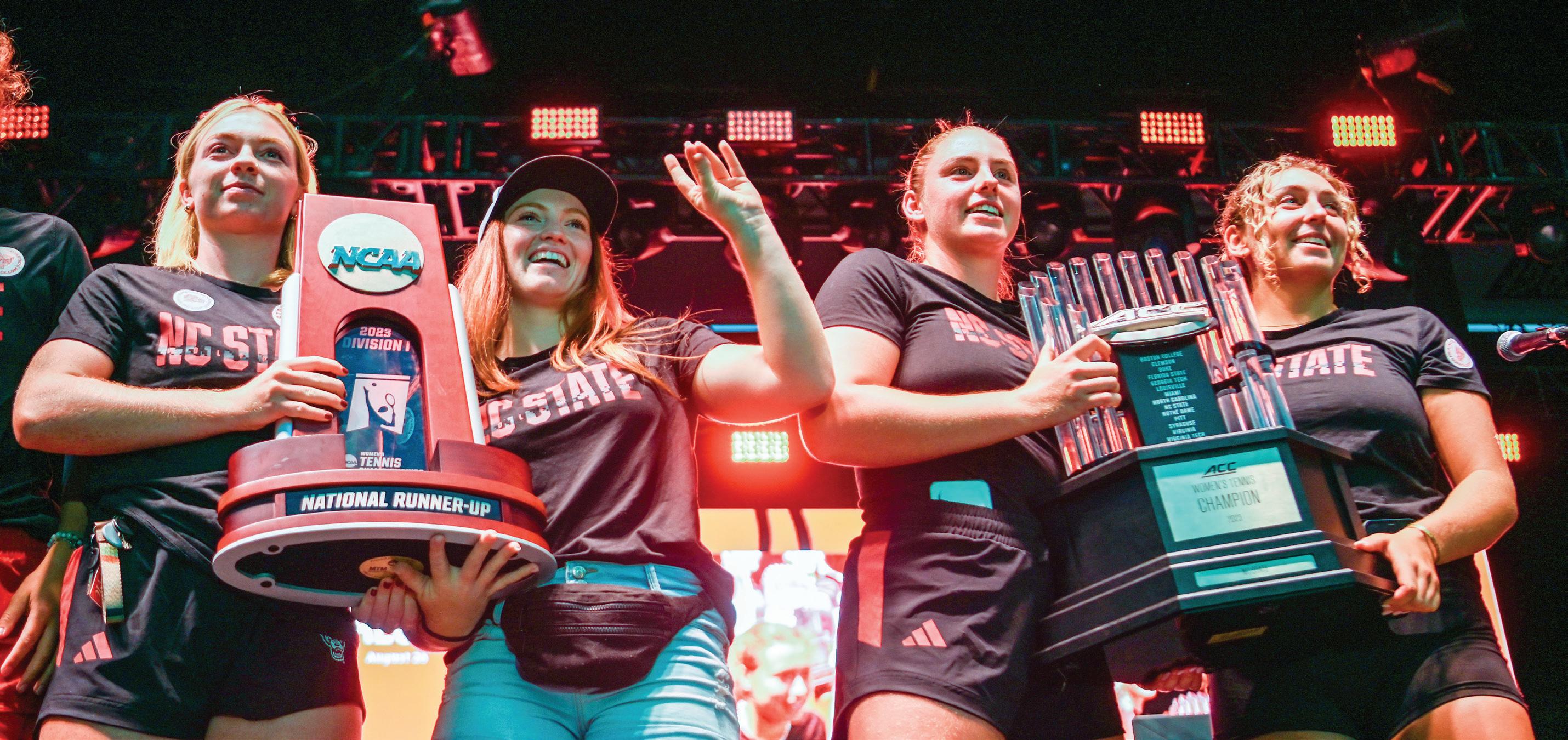 Erin Ferrare Assistant Sports Editor
Erin Ferrare Assistant Sports Editor
NC State men’s athletics has flirted with mediocrity for decades now.
Every year, social media and Raleigh news outlets complain about the “big three” sports on campus — football, men’s basketball and baseball — and how it seems like the Wolfpack always finds a way to disappoint its fans. Every year men’s teams let down the red-and-white faithful. But the women of the Pack do not; women have always been the best on campus.
This article is for a specific audience. It’s not for the thousands of fans that have sold out every women’s basketball home game this season. It’s not for the fans who create welcoming spaces at every women’s match or game. This article is for the users who comment “Who cares?” under women’s athletics pages, and it’s for the people who don’t believe women’s athletics are just as valuable as men’s.
Women’s athletics at NC State started in 1965, when two women joined the rifle team and another woman joined the fencing team. This came only four years after the University became coeducational. It wasn’t until 1973 that NC State Athletics sponsored women-only squads, with women’s basketball being the first women’s varsity team on campus.
With the introduction of Title IX in 1972, NC State women finally got to the same level as the men on campus, and they performed immediately. Football and men’s basketball
had been a part of NC State’s culture for a while before women’s basketball came on campus, but since 1974, the ladies of the court have completely blown the two men’s teams out of the water.
NC State women’s basketball didn’t have its first losing season until 1987-88, 14 seasons after the program was created, and since then it has only had five more losing seasons. Since 1973, NC State football has had 15 losing seasons and men’s basketball has had 11.
While the men’s basketball and football teams at NC State aren’t bad, they typically produce mediocre seasons that get more attention than phenomenal women’s seasons. Wolfpack men’s teams have had great seasons — specifically wrestling and swimming — but even those teams have to fight alongside women to gain attention from fans.
The most recent men’s champions come from the swimming and wrestling teams, and baseball brought home an NCAA Super Regional championship in 2021. For the other men’s teams on campus, you have to travel far back in time to see the same level of success. Football’s last meaningful achievement came in 1979 when it won the ACC Championship, and men’s basketball hasn’t had much success since 1988 when it was the ACC regular season champion. Men’s soccer and track haven’t claimed championships since the 1990s, while men’s tennis only has one trophy to its name from 1980.
Since 2018, NC State women have brought home nine ACC Championships, three NCAA Championships, two ACC regular season championships and a NCAA Final
Four appearance. As long as women’s athletics have been at NC State, they’ve consistently brought home accolades and trophies through every decade. Volleyball and women’s soccer are the only sports on campus that have not had any major accomplishments since 1988.
Recently, NC State has done a better job promoting women’s athletics, but many fans still seem disinterested. Generations of alumni who went to this school in the early days of women’s athletics are still holding onto the so-called “glory days” of Wolfpack football and men’s basketball and do not feel the need to support the rise of women’s athletics. The business of sports was invented by men, for men and has never been fair to women. But over the past year, women’s sports have skyrocketed. In August 2023, Nebraska volleyball hosted a match in its football stadium which drew over 92,000 in-person attendees and 518,000 viewers on television. Iowa guard Caitlin Clark broke the record for the most points in Division 1 Women’s NCAA Basketball and just surpassed Pete Maravich to grab the all-time NCAA scoring record.
It is predicted that “women’s elite sports,” including the NCAA, will produce over $1.28 billion in 2024, which is a 300% increase from 2021.
Even though women’s athletics has produced great athletes and events since they were brought to the NCAA, they still are faced with an uphill battle. We need to stop applauding mediocrity and instead build a culture that promotes winners, no matter what gender they are.
TECHNICIANONLINE.COM TECHNICIAN 13 THURSDAY, MARCH 7, 2024 Sports
HALLIE WALKER/TECHNICIAN
(Left to right) Women’s tennis freshman Chloe Henderson, junior Sophie Abrams, junior Amelia Rajecki and junior Abigail Rencheli hold up their ACC and NCAA trophies during the pep rally at Packapalooza at Hillsborough Street on Saturday, Aug. 26, 2023. Packapalooza is a street festival that celebrates the beginning of the new school year.
Saniya Rivers’ ascension to stardom COLUMN
Connor VanDerMark Correspondent
NC State women’s basketball has been one of the most captivating sports for the Wolfpack. After failing to meet expectations last year, NC State women’s basketball was able to flip the script this year, becoming a consistent top-10 team in the country due in large part to junior guard Saniya Rivers. After winning ACC Sixth Man of the Year last season, Rivers was given the opportunity to become the starting point guard.
She took the role and has never looked back since, helping the Wolfpack to a 25-5 overall record and a 13-5 ACC record. Rivers, who made the midseason cut for the 2024 Jersey Mike’s Naismith Trophy for the national player of the year, excels in every aspect of her game and has many important qualities that make her such a good player.
Clamp artist
Rivers’ six-foot-one frame and athleticism make her a ferocious defender. At first glance, she has all the attributes you would want in a defender, and she backs up every claim on the stat sheet. She is averaging almost one block per game and 2.4 steals per game, placing her third in the ACC. Rivers is also fifth in the conference in defensive rating and second in defensive box plus/minus, both important markers in advanced statistics for elite defenders.
Rivers had multiple great defensive games, but none better than her game against Notre Dame. Up against freshman phenom Hannah Hidalgo, who averaged 25.1 points per game at the time, Rivers was drawn as the primary defender and stepped up to the challenge, shutting out Hidalgo in the first half and holding her to eight points in total.
Clamping the number three scorer in the nation is no small feat, and the accomplishment further proved that Rivers would be a tough matchup for anyone.
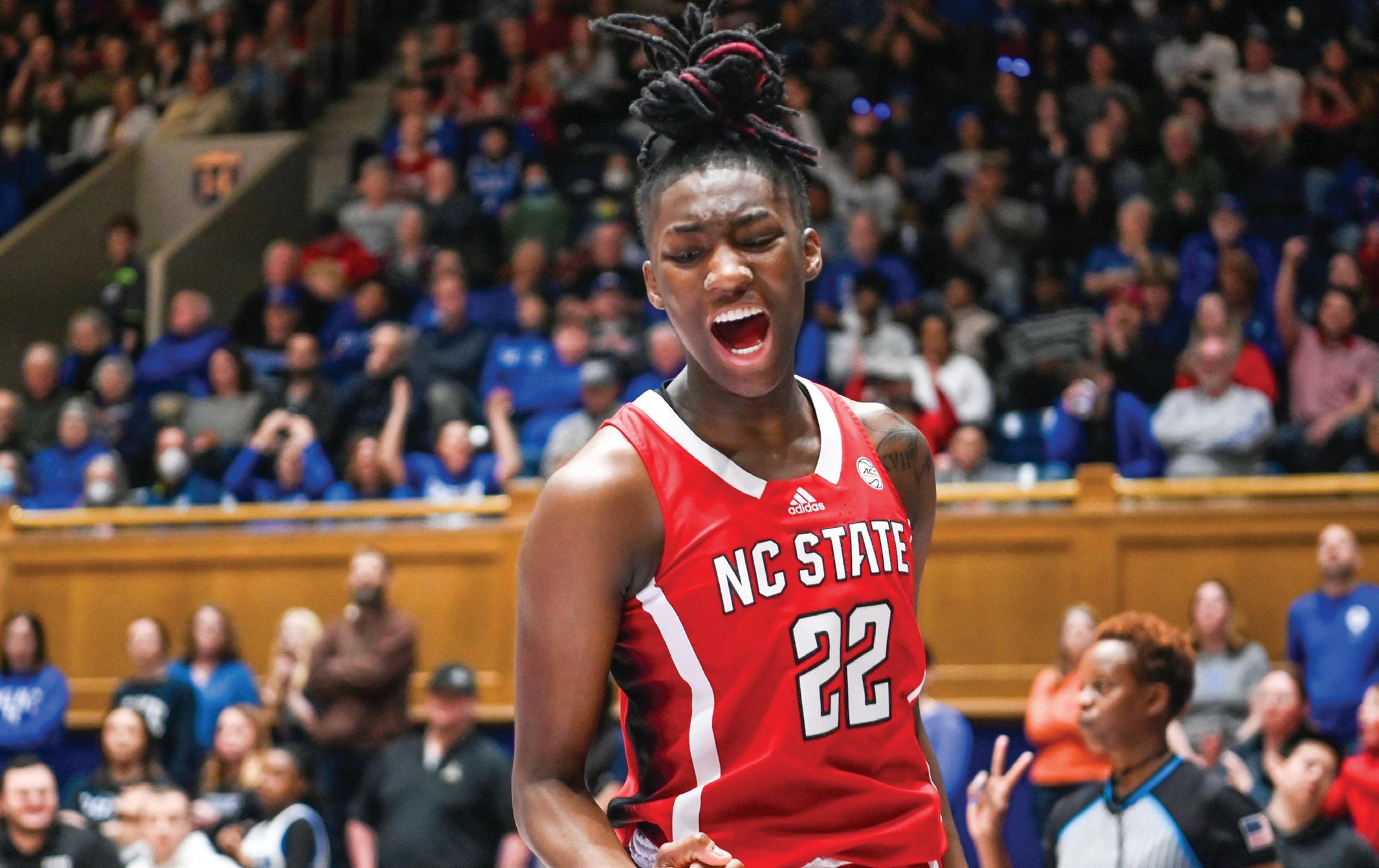
Unrelenting energy
Rivers earned the nickname “The Go” from head coach Wes Moore, and for good reason. Her hustle is second to none and is the key force behind the momentum of the Wolfpack. Her defensive prowess usually results in her guarding the best player, and you can guarantee she will give maximum effort on every single drive.
Rivers averaged 34.6 minutes per game this season, meaning she had just over five minutes of rest time per game. Yet, she was still the most persistent player on the court and consistently created fast break opportunities for her squad. In the Wolfpack’s overtime victory against then-No. 19 Syracuse,
Rivers played all 45 minutes, only resting during timeouts and halftime.
Against Georgia Tech, she emphasized the importance of playing hard for the entire game.
“You’ve got to play until the buzzer,” Rivers said. “This game was 45 minutes. You’ve got to play until the buzzer and as you can see, anybody could’ve won.”
Pack leader
Her defense and hustle make Rivers better as an individual, but it goes further than that. She is a key leader on this team. After coming off the bench last season, she stepped into an important leadership role
and helped turn the team into the powerhouse it is today. She isn’t afraid to make the tough decisions, making her the primary guard whenever the team needs a bucket, and she made that apparent in NC State’s home victory over UNC-Chapel Hill.
“I don’t like yelling at people,” Rivers said. “But when it comes to crunch time and I have to get my teammates in order, I do what I’ve got to do.”
Rivers’ leadership has led the Pack to the No. 2 seed in the ACC Tournament, securing an important double-bye that advances them directly to the quarterfinals.
The Wolfpack will play one of Duke, Pittsburgh or Georgia Tech at 5 p.m. on Friday, March 8.
NC State softball early season takeaways
Noah Teague Assistant Sports Editor
NC State softball is back and better than ever, and this isn’t last season’s team. Following a trip to No. 11 Clemson, new head coach Lindsay Leftwich has the Wolfpack sitting at 14-5 this year. While the Pack only took one of three games against the Tigers, it proved it could hang with one of the ACC’s best.
From standout players to overall team
success, there are plenty of encouraging trends for the red-and-white. Here are the biggest takeaways from NC State’s first 19 games of the season.
Marbury shining
Sophomore utility player MaKayala Marbury has separated herself as the most dangerous bat in the Pack’s lineup. Through 19 games, Marbury has a .389 batting average
and a team-high 18 RBIs. What stands out most is Marbury’s power — with six home runs and two triples already, she’s always a threat to score when she steps to the plate. While Marbury’s best moments have come at the plate, she’s also proven to be dangerous running the bases. Marbury leads the team with eight stolen bases, while only getting caught stealing once. The sophomore’s effectiveness and efficiency have been key for the Wolfpack, especially
looking forward to ACC play.
Strong pitching
Redshirt senior righty Aisha Weixlmann has proven to be a star in the pitching circle, leading the red-and-white with 35 strikeouts.
SOFTBALL continued page 15
TECHNICIANONLINE.COM 14 TECHNICIAN THURSDAY, MARCH 7, 2024 Sports
HALLIE WALKER/TECHNICIAN
Junior guard Saniya Rivers celebrates making an and-one layup during the game against Duke at Cameron Indoor Stadium on Sunday, Feb. 25, 2024. Rivers scored 13 points and eight rebounds. Duke beat NC State 69-58.
SOFTBALL
continued from page 14
Weixlmann has posted a 5-1 record, including an impressive 6-1 win over Clemson. In six innings against the Tigers, Weixlmann only allowed four hits and no runs, while striking out five batters. The win over Clemson served as an exclamation point to a strong season start.
Weixlmann hasn’t been the only star pitcher for the Wolfpack — sophomore right-handed pitcher Madison Inscoe has excelled in her right. While Weixlmann has been the strikeout queen, Inscoe has displayed the best control. With only nine walks in ten games, Inscoe rarely gives opponents free bases and she also boasts an impressive 2.73 ERA.
Patience at the plate
Patience at the plate has paid major dividends for NC State, resulting in pitchers being forced to throw favorable pitches or walk batters. The Pack is currently tied for second with Georgia Tech for the most walks in the ACC at 77. With a consistent flow of walks, the Wolfpack has gotten on base without always having to put the ball in play, reducing the risk of suffering outs.
Consistently winning
Maybe the most exciting development for NC State this season has been its quick start — especially when contrasted to last season’s constant struggles. While 2023 was marked by a midseason coaching change and losing streaks, the Pack has completely reversed its play this season. Following a 1-3 start, the Wolfpack rattled off 13 consecutive wins, nearly as many wins as the team had last season.
Additionally, the Pack has established a strong home-field advantage. The red-andwhite is 10-0 at Dail Softball Stadium — drastically better than its 16-14 home record in 2023. With the team winning and fan interest growing, the Pack’s home-field advantage should only strengthen.
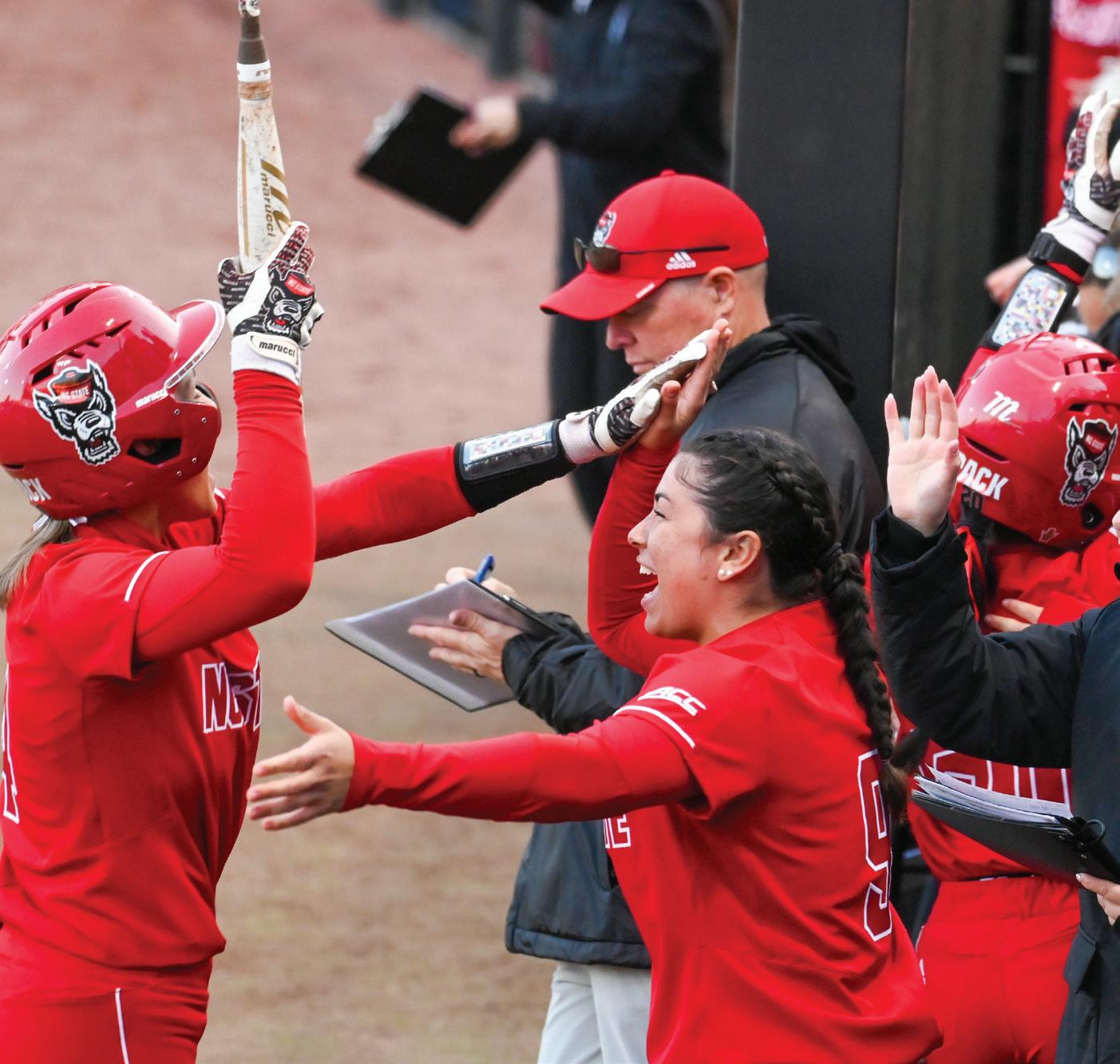

TECHNICIANONLINE.COM TECHNICIAN 15 THURSDAY, MARCH 7, 2024
Sports
JERMAINE HUDSON/TECHNICIAN Freshman infielder/outfielder Tori Ensley celebrates scoring a run with the NC State softball team during the game against App State at Dail Softball Stadium on Sunday, Feb. 25, 2024. NC State beat App State 6-2.

























 Will LaMarche Staff Writer
Will LaMarche Staff Writer

 Erin Ferrare Assistant Sports Editor
Erin Ferrare Assistant Sports Editor



